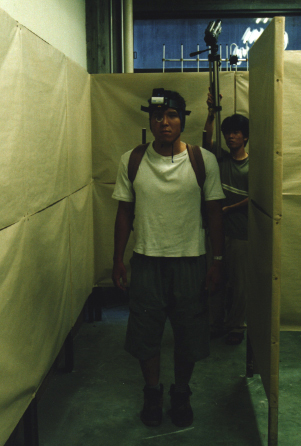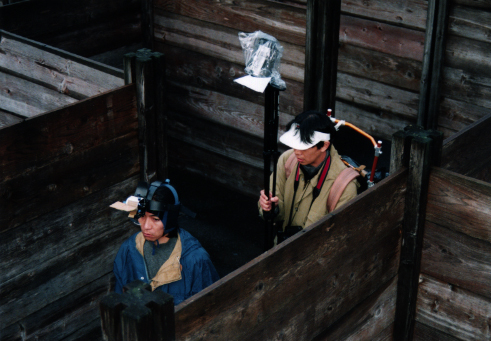Tohru Kitahama, Toshiaki Miura, Shigeyuki Okazaki, Kazumitsu Shinohara, Tamura Hitoshi and Yuko Matsui
Visual Search and Pedestrian Movements in Wayfinding through a MazeThe Japanese Journal of Ergonomics, Vol.35, No.3, pp.145-155, 1999.6 (in Japanese)Despite their importance to research, there exist almost no experimental studies on the relationship between visual search (eye movement) and walking (head and body movement) in 'way finding'. The current research aims at developing a method to analyze 'way finding' behavior and at revealing some characteristics of the coordination of eye and head/body movement. In the experiment, subjects wore an eye camera and walked two or three times through a maze from a starting point to a goal until the entire path was learned. Subsequently, the subjects were asked to make sketch drawings, and an image map of the maze from memory. Complex data, such as distribution of fixation points, fixation duration, sight distance and pedestrians' head/body movement patterns were systematically analyzed. Through this developed method, several characteristics of coordinative eye and pedestrian movement in 'way finding' were revealed. The relationship between visual search and recalled drawing of the path was also discussed. PDF(6,707KB, in Japanese)
Shigeyuki Okazaki, Tohru Kitahama, Toshiaki Miura and Kazumitsu Shinohara, Changes in Eye-head-body Movements During Maze LearningPerceptual and Motor Skills, Vol. 91, pp.1230, 2000.12 Investigation of the relationship between visual search (eye movement) and walking (head and body movement) during way-finding through a maze by each of 6 subject pedestrians who wore an eye camera showed patterns of sight line, head movement, body movement, and changes of coordination between eye-head-body movement during the process of comprehension of the pathways were revealed. PDF(310KB)
Shingo Nakamura, Tohru Kitahama, Takashi Tokunaga, Hitoshi Tamura and Shigeyuki Okazaki, A Study on the Movement Patterns of Sight-lines in terms of Duration of Fixation and Fixation Distance- Fixation and Pedestrian Movements on Wayfinding in a Maze Part1 -Summaries of technical papers of Annual Meeting Architectural Institute of Japan, E-1, pp.833-834, 1998.9 (in Japanese)
Takashi Tokunaga, Tohru Kitahama, Shingo Nakamura, Hitoshi Tamura and Shigeyuki Okazaki, A Study on the Relationships of Fixations and the Direction of Head and Eye- Fixation and Pedestrian Movements on Wayfinding in a Maze Part2 -Summaries of technical papers of Annual Meeting Architectural Institute of Japan, E-1, pp.835-836, 1998.9 (in Japanese)
Shingo Nakamura, Tohru Kitahama, Takashi Tokunaga, Hitoshi Tamura and Shigeyuki Okazaki, A Study of Eye Movement and Pedestrian Movement on Wayfinding in a MazePart1. A Study on the Movement Patterns of Visual LinesTechnical Papers of AIJ Kinki Brunch, Vol.38, Planning, pp.221-224, 1998.7 (in Japanese)
Takashi Tokunaga, Tohru Kitahama, Shingo Nakamura, Hitoshi Tamura and Shigeyuki Okazaki, A Study of Eye Movement and Pedestrian Movement on Wayfinding in a MazePart2. A Study on the Fundamental Characteristics of Fixations and Pedestrian MovementsTechnical Papers of AIJ Kinki Brunch, Vol.38, Planning, pp.225-228, 1998.7 (in Japanese)
|

|



